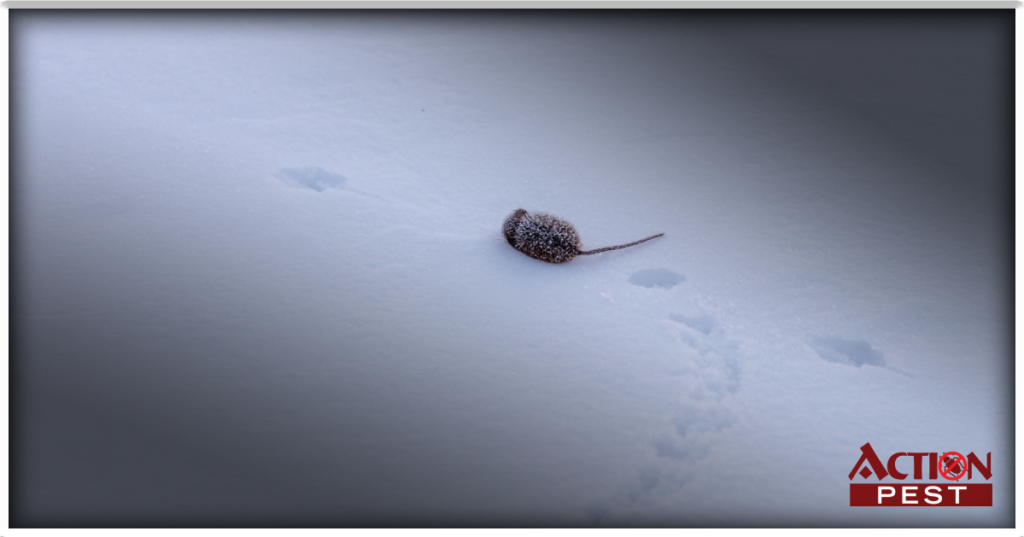
Winter is a great time to get cozy and enjoy a cup of hot chocolate while your neighbors build their perfect snowman with their teenagers. While you’re busy working on your bucket list and making plans, it’s Christmas time for rodents, as they aggressively stock their supplies for the coldest time of the year.
Using a track is the easiest way to identify if you’ve got a rat infestation in your house. While you could sleep on this, the problem could grow as these little rodents breed multiple times during the year.
How Do I Know If There Are Tracks?
There’s a popular misconception that rats hibernate. While this is true for rodents like squirrels and certain mice, rats do not hibernate. Instead, they are almost always in search of food. Rats stock some of their food to avoid leaving their warm burrows but almost always come out in the snow, leaving a foraging path for you to observe.
After fresh snowfall, you can look at these tracks near food sources and rats aren’t the pickiest eaters. They eat anything they can find including garbage, clothes, leftover food, and vegetables. Rat or mouse tracks will most commonly be found around dumpsters.
Mouse Vs Rat Tracks
Rat tracks are easy to spot. A rat’s hind foot is larger than a mouse and leaves a track close to an inch. Rats also have a thicker and longer tail which drags around as they run between their home and food source. They instinctively like using the same path, and if you see the same tracks appearing at the same location, you’re likely living with some uninvited guests.
Mouse tracks are much smaller than rats, their tracks are smaller than ½” and they like living somewhere dark that is close to a food source, usually inside the house near the kitchen. They travel along the edges of the wall and if outside, they usually hop in the snow, leaving tracks near a bird feeder and towards their burrow. If you happen to find mouse tracks, they usually lead towards the nearest wall of the house.
Where Do The Tracks Lead?
The best time to search for these reappearing tracks is, after a snowfall that covers your patio or lawn with a thick layer. Looking for rat tracks during snowfall that instantly melts or snowfall that covers the streets in dark dirty slush isn’t the best day for track hunting.
The rat tracks, other than identifying your rodent problem, can tell you about the severity of the infestation and where all the rats hide.
Burrows
Rat tracks either lead to a food source or to their burrows. Rats like to dig burrows about 18” deep and take all their nesting materials inside their dark burrows to reproduce. These burrows are a source of heat for these rodents in the winter and also where they stockpile their food. This doesn’t mean they will never come out. Rats will leave tracks over snow in search of water.
Other than having a burrow next to or beneath a rock, they tend to find a way inside the house, where the threat of predators is greatly reduced. This is an easier option than digging and most rats are great at chewing away wood or softer foundations.
Entry Points
Looking for tracks around the house is the best way to search for entry points of these pests and invaders. Mice tracks are usually found around the house, near the wooden stairs or cables that run along the house. Any space in these cable lines and walls can serve as an entry point. You can easily spot an entry point by looking for nesting material that is left behind the rats or mice as it cannot squeeze through those tiny gaps. Chewed floor boards, material like paper and grass around the corner of your house is usually a good sign, an entry point is nearby.
Track Hunting Tips
Of course! You aren’t the most experienced person dealing with a rat problem. You can still start a small analysis of how bad the situation is, with a few of these track hunting tips.
- Fresh snowfall is the best time to head out and look for rat tracks. The snow is soft and the tiny weight of these rodents leaves easily visible foraging tracks.
- Tail is the easiest way to differentiate between rat and mouse tracks. Rat tracks leave close to 5” tail drag between their footprints.
- Tracks are between two points, either their burrow or their food source. It’s best to look for their nesting place closer to your house first. Following the tracks in the other direction will be the prior location of the rats, not the latest.
Rat Infestation Signs
If you see rat tracks around your garbage, dumpster or house, there’s no need to panic. These rats can be from the sewers searching for food where you throw your garbage or occasionally come searching for seeds or nuts.
However, lookout for these signs, to timely control your rat infestation.
- Droppings are the most evident sign of a rat infestation. If you see rat droppings (curved and pointed end, about ½”) repeatedly after cleaning, this is the only sign you need for a rat infestation.
- Chewed material around the house is another big sign of a rat infestation. Rats have incisors that grow constantly and to keep them in check, they regularly chew on hard surfaces like bins and plastic.
- Dark marks at the same spot inside the house near the edge of a wall means the rats are using the same path, and body oils, dirt and fur constantly contacting the paint leaves these spots.
- Nesting material around the house that is naturally out of place like chewed fabric on the patio or grass around the wall, is another sign of a rat making a way into your house.
Need Your Pest Problem Solved? Give Us a Call
Reach us today for a professional removal of your rodent problem and a one-time solution for your rat infestation.
At ActionPest, we believe in providing our clients with the best analysis of their pest infestation and an upfront quote without any hidden charges. We feature client testimonials from some of the largest Canadian companies and homeowners that might just be your neighbors!
Give our helpful staff a quick call and get same day services in Hamilton, Oakland and surrounding territories.
FAQ
Do rats leave tail marks in the snow?
Rat tracks are easily identified with their larger hind marks and a tail impression on dust or snow left behind by these rats.
Mice vs Rat tracks
Rat tracks are larger than mice which are about ⅜”. There’s also a line between these tracks left behind by the large rat tail.
Do rats go out in snow?
Rats stockpile in their burrows, but they have to go out in search of water and fresh food. Rats will almost always be out looking for more food just at the start of winter.
How do I identify a rat track?
Rat tracks can be identified by footprints left behind on dust and snow, these are about an inch long and usually a rat leaps in the snow. So, expect track density similar to a rabbit. There’s also a large tail dragging on snow and this is seen between the prints of the rat.







